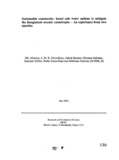| dc.contributor.author | Jakariya, Md. | |
| dc.contributor.author | Chowdhury, AMR | |
| dc.contributor.author | Hossain, Zabed | |
| dc.contributor.author | Rahman, Mizanur | |
| dc.contributor.author | Sarkar, Quaiyum | |
| dc.contributor.author | Khan, Ruhul Islam | |
| dc.contributor.author | Rahman, Mahfuzar | |
| dc.date.accessioned | 2019-12-23T09:38:29Z | |
| dc.date.available | 2019-12-23T09:38:29Z | |
| dc.date.issued | 2003-05 | |
| dc.identifier.citation | Jakariya, M., Chowdhury, A., Hossain, Z., Rahman, M., Sarkar, Q., Khan, R. I., & Rahman, M. (2003, May). Sustainable community- based safe water options to mitigate the Bangladesh arsenic catastrophe - an experience from two upazilas. Research Reports (2003): Social Studies, Vol – XXXI, 130–136. | en_US |
| dc.identifier.uri | http://hdl.handle.net/10361/13336 | |
| dc.description.abstract | Sustainable community-based safe water options have been successfully operating in two upazilas
involving 531 villages and encompassing a population of 497,488. Testing of tubewells for arsenic
was carried out on a census basis by trained village health workers (VHWs) using the Merck fieldtesting
kit. A total of 51,685 tubewells were tested and further verified both in the field and laboratory.
VHWs initially identified suspected arsenicosis patients who were later confirmed by physicians.
A total of 403 patients were identified. The prevalence rates of arsenicosis were 106/10,000
in Sonargoan and 57/19,000 in Jhikargachha upazilas. The average age of the patients was 36 and
30 years respectively and the majority belong to the 15-45 years age group. There has been close
community involvement at all stages of implementation of the arsenic-free safe water options
adapted from various sources, giving preference to the community-based options to ensure local
participation and utilize knowledge. Potential sources of arsenic-free drinking water were identified.
To ensure sustainable use provided options were assessed based on community acceptability,
technical viability, and financial viability. The key to the success of the project has been the combination
of close integration with the community at all stages and appropriate technical solutions. | en_US |
| dc.language.iso | en | en_US |
| dc.publisher | BRAC Research and Evaluation Division (RED) | en_US |
| dc.subject | Safe water | en_US |
| dc.subject | Arsenic | en_US |
| dc.subject | Mitigation | en_US |
| dc.subject | Rural community | en_US |
| dc.subject | Tubewell | en_US |
| dc.subject.lcsh | Arsenic--Toxicology | |
| dc.subject.lcsh | Arsenic--Environmental aspects | |
| dc.subject.lcsh | Water--Pollution | |
| dc.subject.lcsh | Water--Purification--Arsenic removal | |
| dc.title | Sustainable community- based safe water options to mitigate the Bangladesh arsenic catastrophe - an experience from two upazilas | en_US |
| dc.type | Research report | en_US |

